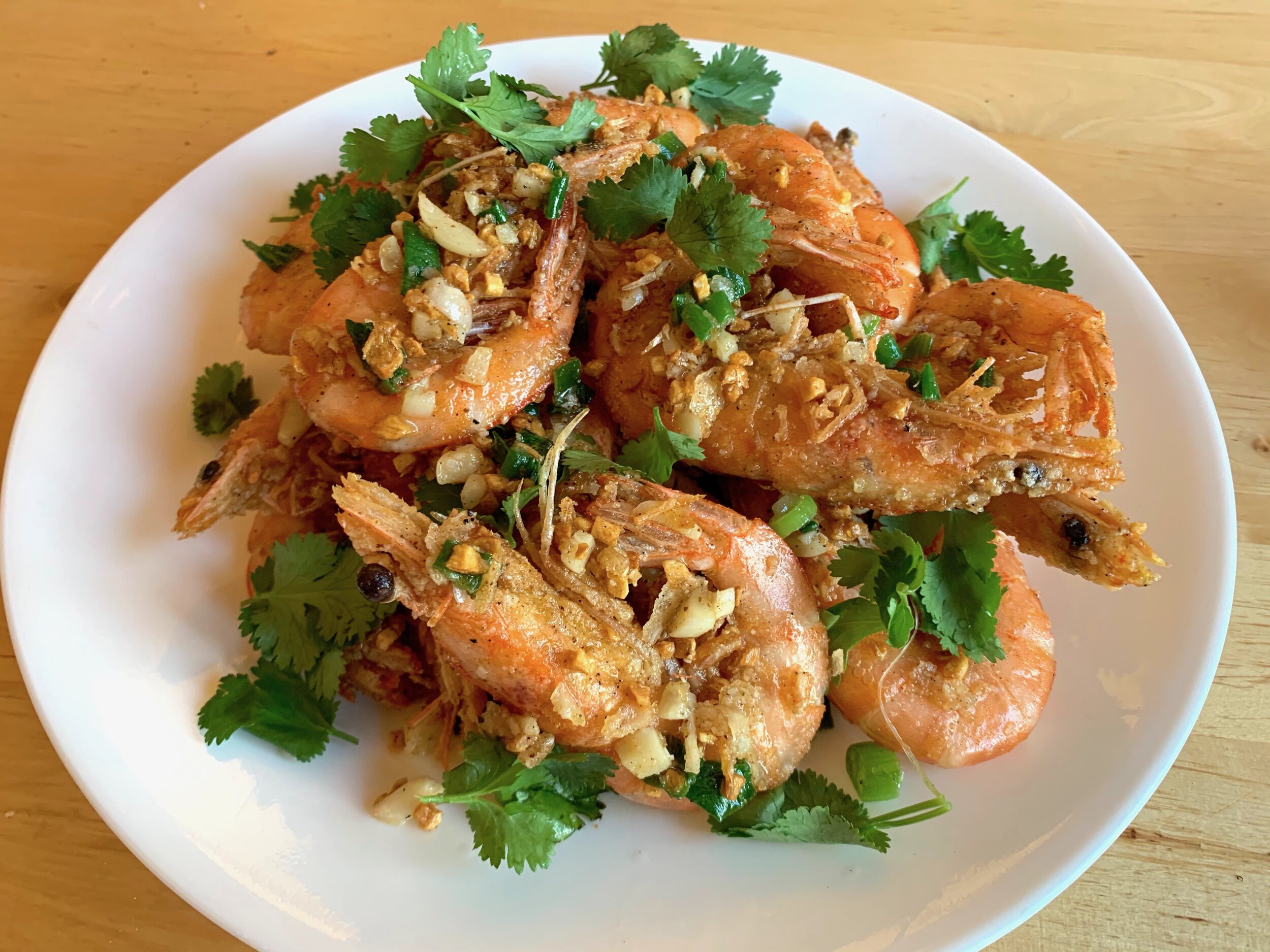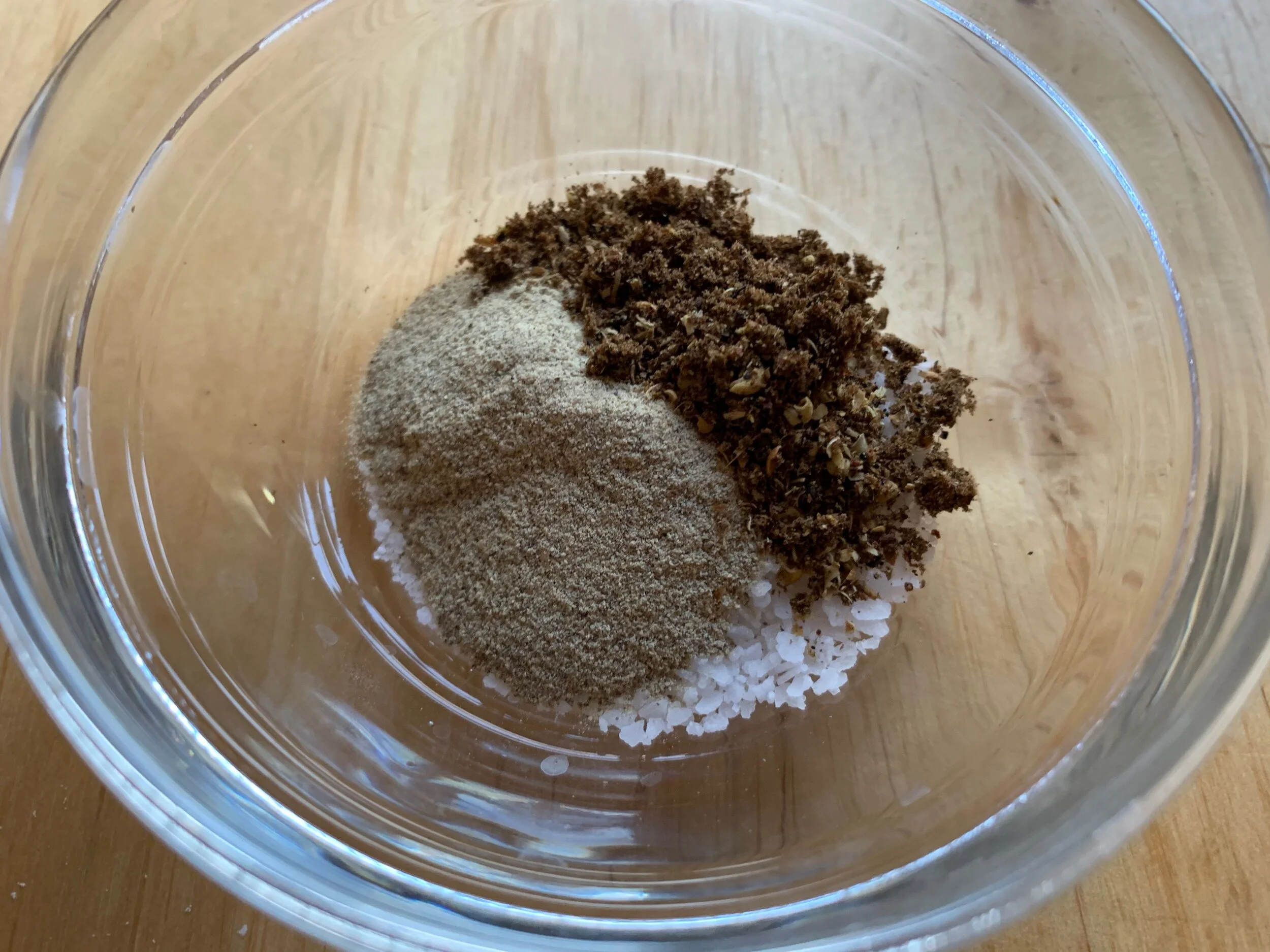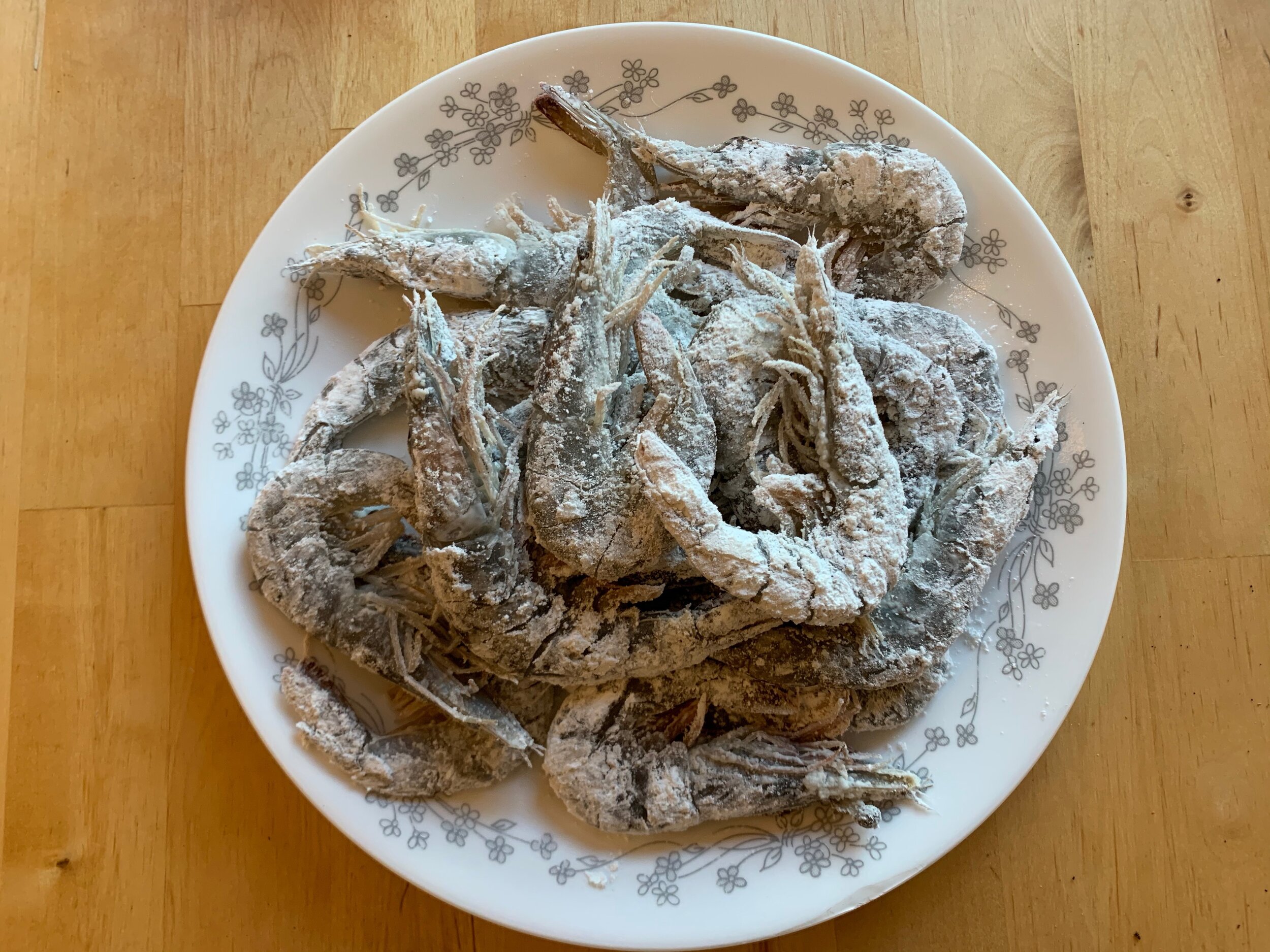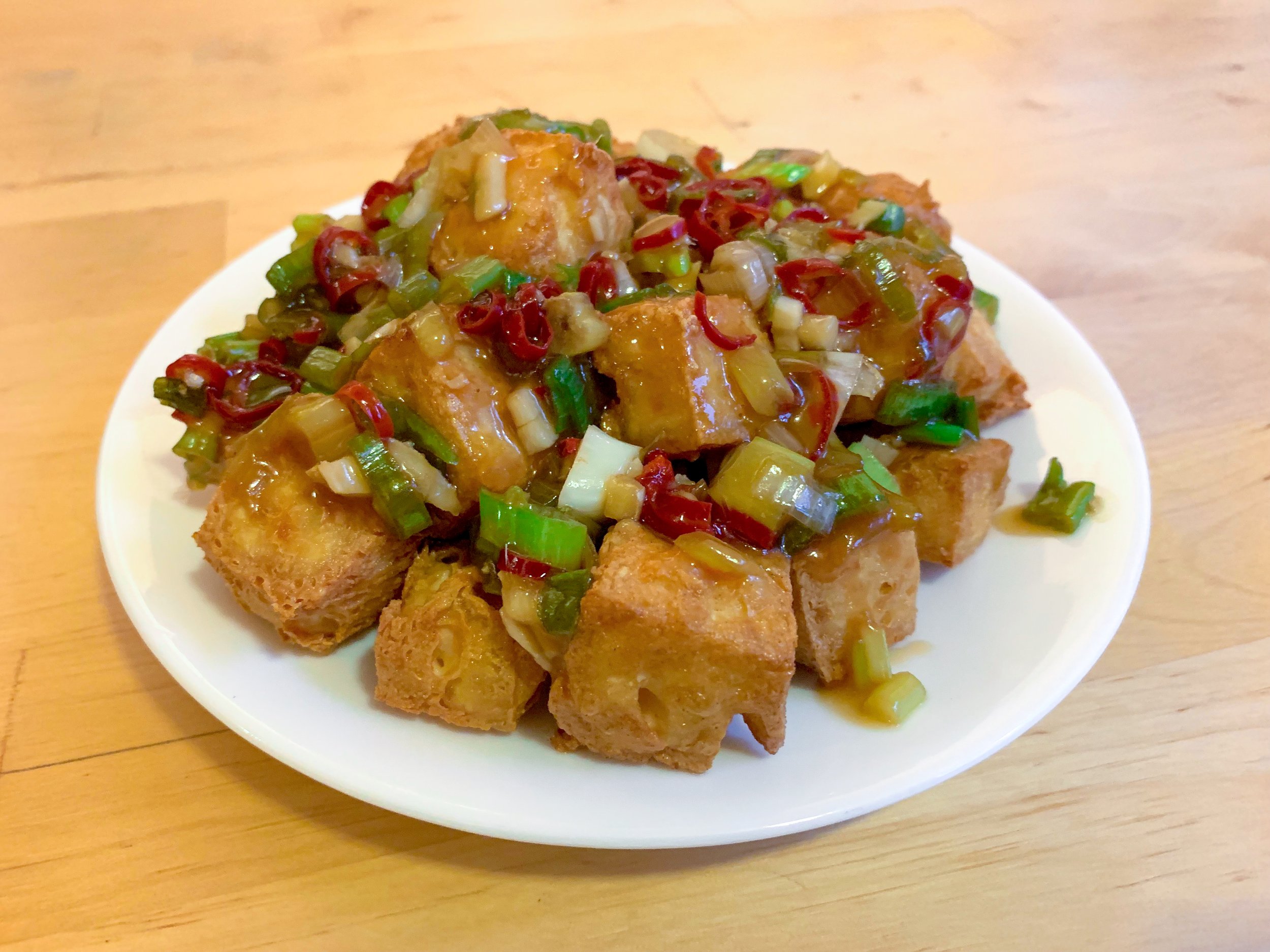Salt and Pepper Shrimp

椒鹽蝦 (Jiao Yan Xia)
Salt and pepper shrimp is a dish commonly found in Cantonese restaurants. Crispy, juicy shrimp tossed with spices and lots of fried garlic—what’s not to love? Our version of this dish uses a combination of white pepper and Sichuan pepper,[1] as they bring two different kinds of heat to the party—the warming spice of white pepper and the numbing spice of Sichuan pepper.
Ingredients
1 lb large shell-on shrimp
3 tbsp cornstarch
1 tsp kosher salt
½ tsp white pepper
½ tsp Sichuan pepper
2 cloves garlic, minced
2 tbsp fried garlic
1 scallion, chopped
Cilantro leaves (optional)
Vegetable oil
This dish works best with large shrimp. Brands are not consistent about terms like “Large,” “Extra Large,” or “Jumbo,” so look for shrimp which count at 21-25 per pound. Anything between 30 per pound to 15 per pound can work in this recipe, provided you adjust cooking times appropriately.
When cooking whole shrimp, there are a few things we have to take care of before they hit the pan. Unlike larger crustaceans, however, which often call for heavier equipment, all we will need for shrimp are a pair of kitchen shears. First, trim any long antennae, which are inedible and difficult to handle when cooking.[2] Next, we have to remove the head spine of the shrimp, called the rostrum. This hardened projection from the carapace is intended to defend the shrimp’s head from frontal attack, and is often festooned with barbs. We don’t want this anywhere near our mouth! Snip it off with shears. Devein the shrimp by snipping along the back of each shrimp with kitchen shears and pulling out the vein.
Before we start cooking, be sure that you have your garlic minced and scallions chopped. We won’t need these ingredients until we make the topping later, but once the shrimp hit the oil things will move very quickly, so it is better to do our mise en place. Let’s also prepare our salt mixture by combining ½ a teaspoon of kosher salt with ½ a teaspoon white pepper and ½ a teaspoon Sichuan pepper. If you want a spicier dish, feel free to increase the amounts of pepper. While Sichuan pepper retains its numbing heat for a long time in ground form, the aromatic lemony fruitiness of Sichuan peppercorns does not last long after being ground. Therefore, if possible, it is best to grind the Sichuan peppercorns yourself.
Mix 3 tablespoons of cornstarch with ½ teaspoon kosher salt to make our dredging mixture. We aren’t including any spices in the dredge, as spices can burn in the hot oil. Dredge each of the shrimp individually, shaking off the excess. We are looking for a thin coating of cornstarch—it’s okay if not every part of the shrimp is coated.
Pour a neutral-flavored frying oil into your pan to a depth of half an inch. Depending on the size of your pan, this is probably between ½ a cup to 1 cup of oil. Bring the oil up to 375° F, then carefully lay the shrimp into the pan. We can only cook a single layer of shrimp at a time, and we don’t want to crowd the pan, so work in batches if necessary—probably there will be at least two rounds. Fry the shrimp for about 1 minute per side, or until just cooked through. Color is a good indicator of doneness for shrimp, so judge for yourself when they are cooked—smaller shrimp might be done with only 30 seconds per side, while really large ones might take more than 1 minute per side.
Once the shrimp are done, remove them from the oil and place them in a large metal bowl (these are best for tossing!). Sprinkle the salt and pepper mixture over the shrimp, tossing occasionally to evenly distribute the seasoning. You should do this while the shrimp are still very hot, so the seasoning sticks.
When you’re done frying, don’t throw away the oil! The shrimp shells have infused the oil with a ton of shrimp flavor through the frying process. Once the pan is cool, you can strain and store this shrimp oil. You will notice that the oil has turned a brilliant red color. It is great for dipping dumplings into, or for drizzling over ramen.
Once the shrimp is done, immediately switch gears to make the garlic scallion topping. Work quickly here, as the shrimp will cool quickly! We will be using a mix of fried garlic and fresh minced garlic in the topping—the fried garlic brings a crunchy texture, while the fresh garlic retains its aromatic punch. If you don’t have fried garlic readily available, you can deep fry some minced garlic in the oil before frying the shrimp. You can also choose to use only fresh garlic, in which case use 4 cloves total.
In a small pan over medium heat, heat a couple tablespoons of the shrimp oil. Add the minced garlic, fried garlic, and scallions to the pan, and toss for about 1 minute, or until fragrant. Pour the hot garlic and scallion mixture over the shrimp and toss well. Plate, top with cilantro leaves, and serve immediately.
How do you eat head-on shrimp at the table? As with most shellfish, it does get a bit messy! Twist the tail off of the head, and start by eating the shrimp tail. Deep-fried shrimp shell is edible, and if cooked correctly, can be as shatteringly crisp as fish skin or pork crackling. In this dish, you can eat nearly the whole tail, shell and all. Then you can suck on the shrimp heads to extract all of the goodness there!
Substitutions
You can substitute potato starch or sweet potato starch for the cornstarch. If you want your shrimp a bit spicier, garnish with some sliced fresh chili peppers—long green peppers or jalapenos both work well. You can also add a bit of minced ginger to the garlic and scallion topping. If you’re looking to add an American twist to this dish, a teaspoon of Old Bay seasoning in the salt and pepper mixture works really well.
[1] Despite looking similar, Sichuan peppercorns are not closely related to black or white peppercorns. Sichuan peppercorns are the fruit of the Chinese prickly ash (Zanthoxylum simulans), while black and white peppercorns are the fruit (harvested at different times) of the Piper nigrum plant.
[2] Scientists believe that while the short antennae of shrimp are predominantly chemosensory, the longer antennae are used to make tactile contact with other shrimp.
Recipe
Prep Time: 15 min Cook Time: 10 min Total Time: 25 min
Difficulty: 4/5
Heat Sources: 2 burners
Equipment: stainless steel or cast iron pan, thermometer, small pan
Servings: 4
Ingredients
1 lb large shell-on shrimp
3 tbsp cornstarch
1 tsp kosher salt
½ tsp white pepper
½ tsp Sichuan pepper
2 cloves garlic, minced
2 tbsp fried garlic
1 scallion, chopped
Cilantro leaves (optional)
Vegetable oil
Instructions
1. Trim the antennae and head spines off of the shrimp, and devein them.
2. Mince the garlic and chop the scallions, and set aside. Mix together ½ tsp kosher salt with white pepper and Sichuan pepper. Set the salt and pepper mixture aside.
3. Mix cornstarch with ½ tsp kosher salt. Dredge the shrimp in the cornstarch, until each shrimp is lightly coated.
4. In a heavy stainless steel or cast iron pan, heat ½ an inch of oil to 375° F. Fry the shrimp, working in batches if necessary, for about 1 minute per side, or until just cooked through.
5. Remove the shrimp to a large metal bowl, sprinkle over the salt and pepper mixture, and toss well.
6. In a small pan, heat 2 tbsp shrimp frying oil over medium heat. Add the minced garlic, fried garlic, and scallions to the pan. Fry for 1 minute or until fragrant.
7. Pour the garlic and scallion mixture over the shrimp and toss well. Plate, top with cilantro leaves, and serve immediately.






















